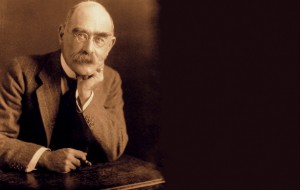Falling Down the Thames Blog 51, 04th March 2015
The River Thames Using Exactly the Right Words
When I was a student in junior high school, our Language Arts teacher asked us to contemplate the nature of poetry. What is a poem? After struggling for the better part of an hour, which may have been the point of the exercise, the class came up with something along the lines of: “A poem is a composition intended to convey emotions and ideas using exactly the right words in exactly the right order.”
Even at the time this definition seemed to me to put an awful lots of pressure on poets. After all, one word out of place and what you had composed wouldn’t be a poem. It also seemed to be a bit unfair to writers using other styles, implying that they were satisfied with wrong words, or words in the wrong sequence.
Many have chosen to encapsulate their emotions and ideas about the River Thames in the form of poems. Among them were the novelist and poet Rudyard Kipling (1865-1936) who as a prelude to his work The River’s Tale wrote :
Twenty bridges from Tower to Kew -
(Twenty bridges or twenty-two),
Wanted to know what the River knew,
For they were young and the Thames was old,
And this is the tale that River told:
That is all very well and good, but by my count Krista and I will be paddling under twenty-five bridges from Tower Bridge to Kew Bridge.
Poet Laureate William Wordsworth (1770-1850) composed Lines Written Near Richmond, upon the Thames, at Evening, in which he was moved to ask of the river:
Glide gently, thus forever glide,
O Thames! that other bards may see,
As lovely visions by thy side
As now, fair river! come to me.
Prothalamion, also known as Sweet Thames Run Softly, by Tudor poet Edmund Spencer (1552-1599) starts off nicely:
Calme was the day, and through the trembling ayre
Sweete-breathing Zephyres did softly play
A gentle spirit, that lightly did delay
Hot Titan’s beames, which did glyster fayre;
But then it gets a bit weird:
There, in a meadow, by the river’s side,
A flock of nymphs I chanced to espy,
All lovely daughters of the flood nearby,
With goodly greenish locks, all loose untied.
If Krista and I espy green-haired nymphs as we pass down the Thames, it may be time to stop paddling. Not all poems about the River Thames are cozy. Alfred Noyes (1889-1958), a professor of literature at Princeton University, felt the need to compose On the Embankment, in which he said:
Within, it was colour and laughter, warmth and wine,
Without, it was darkness, hunger, bitter cold,
Where those white globes on the wet Embankment shine,
Greasing the Thames with gold…
A woman, a woman whose lips had once been kissed,
(It was Christmas Eve, and the bells began their chime!)
She sank to a seat like a crouching bundle of mist,
Exhaled from the river-slime.
Yikes! And if I understand Noyes’ following stanzas, the woman goes on to steal the clothes off a corpse.
It seems that James Kenneth Stephen (1859-1892) was feeling a bit proprietorial about when he wrote Steam-Launches on the Thames in 1891. Paddling – yes. Powered watercraft – no:
Shall we, to whom the stream by rights belongs,
Who travel silent, save, perchance, for songs;
Whose track’s a ripple – leaves the Thames a lake,
Nor frights the swan – scarce makes the rushes shake…
The rush, the roar, the stench, the smoke, the steam,
The nightmare striking through our heavenly dream,
The scream as shrill and hateful to the ear
As when a peacock vents his rage and fear.
My next blog will begin with a poem which speaks to the ever-changing nature of the River Thames.
- Glen
Photo credits: Rudyard Kipling – jrbenjamin.com; sea nymph’s pond – emeraldsemporium.com


